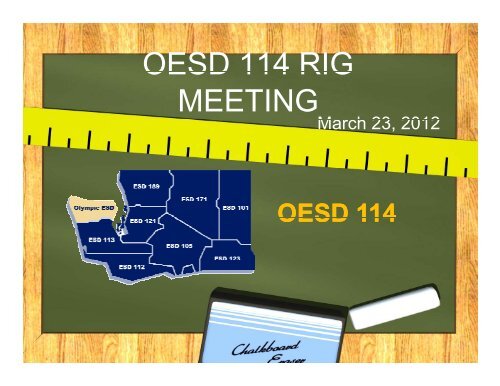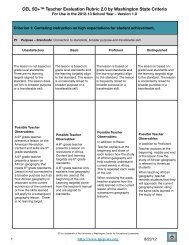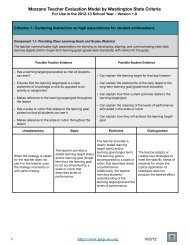PowerPoint Handout
PowerPoint Handout
PowerPoint Handout
- No tags were found...
You also want an ePaper? Increase the reach of your titles
YUMPU automatically turns print PDFs into web optimized ePapers that Google loves.
OESD 114 RIGMEETINGMarch 23, 2012OESD 114
Today’s AgendaWelcome back!Updates– Legislature– TPEP Steering Committee– Other ESDs/ TPEP DistrictsDetermining the 20%Principal Evaluation SystemTeam TimeT DLM
As we begin …What action steps have you takensince our last meeting?What questions have arisen?
UpdatesFrom the legislatureFrom the TPEP Steering CommitteeFrom other RIGs
Legislative UpdateESSB 5895, it’s the law–What’s New–Analysis <strong>Handout</strong>
Additional UpdatesFrom the TPEP Steering CommitteeFrom other RIGs or TPEPDistricts
Determining the 20%•Certificated teachers•All provisionalsincluded in numbersAND participation•No ESAs•No one on Plan ofImprovement
Considerations on the 20%Exceed the 20% given the number of provisionalstatusPilot in all buildingsBalance of career stageVolunteers….random selection…other?
Break
Who Put the “P” in TPEP?
Principal Evaluation SystemComponents of the system– 8 criteria and indicators of each– 4 tiers: Unsatisfactory, Basic, Proficient, Distinguished– Rubrics defining the indicators– Measures and evidence– Summative score
Revised Principal CriteriaCreating a school cultureEnsuring school safetyPlanning with dataAligning curriculumImproving instructionManaging resourcesEngaging the communityClosing the achievement gap
Changes in Principal EvaluationFrom:• Knowledge of, experience in andtraining in recognizing goodprofessional performance, capabilities anddevelopment• School administration and management• School finance• Effort toward improvement when needed• Interest in pupils, employees, patronsand subjects taught in school• Leadership• Ability and performance of evaluation ofschool personnelTo:• Creating a school culture that promotes the ongoingimprovement of learning and teaching for students and staff• Providing for school safety• Leading development, implementation and evaluation of adata-driven plan for increasing student achievement, includingthe use of multiple student data elements• Professional preparation and scholarship• Assisting instructional staff with alignment of curriculum,instruction and assessment with state and local districtlearning goals• Monitoring, assisting and evaluating effective instructionand assessment practices• Managing both staff and fiscal resources to support studentachievement and legal responsibilities• Partnering with the school community to promote studentlearning• Demonstrating commitment to closing the achievement gap
Relationship of RevisedRelationship of RevisedTeacher and Principal Criteria
Teachers:“fostering and managing a safe, positive learningenvironment.”“collaborative and collegial practices focused onimproving instructional practice and studentlearning.”Principals:“creating a school culture that promotes theongoing improvement of learning and teachingfor studentsand staff.”“providing for school safety.”
Teachers:“providing clear and intentional focuson subject matter content and curriculum.”Principals:“assisting instructional staff with alignmentof curriculum, instruction, and assessmentwith state and local district learning goals.”
Teachers:Implementing the instructional frameworkPrincipals:“monitoring, assisting, and evaluatingeffective instruction and assessmentpractices.”
Teachers:“communicating and collaboratingwith parents and school community.”Principals:“partnering with the school communityto promote learning.”
Digging into theLeadership FrameworkDivide into groups of between 4 and 6 people.Use the Three Levels of Text Protocol or TextRendering Experience to dig in deeper to thefirst four pages of the document.Debrief as a large group.
Digging into theLeadership FrameworkForm groups of 8Read the definition of each criterion.Underline or highlight hli h the words or phrases ofmajor importance.Read the indicators for each criterion to betterunderstand what is meant for that one.Discuss in small groups to share:– What was included?– What aligns with your thinking?– What was surprising or unexpected?
Digging into theLeadership FrameworkRemain in same groups.Read the rubric language.What distinguishes each of the tiers fromthe other?What are the important t words?
Digging into theLeadership FrameworkDistrict teamsConsider appropriate measures andevidence for each criterion given itsdefinition, indicators and rubric language.Begin to develop a list of possibilities.Use the accompanying handout to record.
Meet Thom WorlundA Principal who is both evaluating andbeing evaluated in the new system
Connections to District InitiativesCultureDataContenttInstructionCommunity
Lunch
What’s on Your “To Do” List?
District Planning TimeUse the Work Plan and Communicationdocuments to determine what you needto do back at home prior to our next timetogether.What?Who?When?Any resources needed?
Reflection TimeHow has your thinking been . . .– Confirmed?– Adjusted?d?– Expanded?
District PlansReports from each district
Adjourn/ Steering CommitteeRemains to discuss1. What could we do differently or better?2. What do you believe are our next steps?








